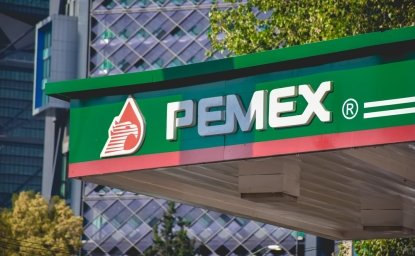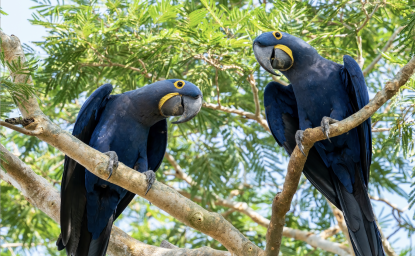An astounding number of species scatter the Amazon rainforest. Monkeys, marmosets, lemurs, and lizards roam; birds flutter about; fish and insects abound, and lush plants flourish in a pristine setting. The Amazon is home to more than 40,000 plant species, of which 30,000 are endemic and unique to the forest; 13,000 types of birds, and more than 500 mammal species.
The Amazon has endured decades of degradation and incursions, yet it remains by far the most expansive, continuous forest in the world, covering more than 1 billion acres. While the future of the rainforest is an issue of global significance and great importance for all eight South American nations that share this environmental and economic asset, with more than 60 percent of the forest located within Brazil, the Amazon is unmistakably Brazilian.
Brazil Institute Director Paulo Sotero observed that as owners and guardians of most of the Amazon, "Brazilians are increasingly aware of the price of failing to protect and preserve it, and are therefore, ever more conscious of their responsibilities."
On January 16, the Brazil Institute, the Environmental Change and Security Program and the Latin American Program sponsored a three-panel seminar at the Wilson Center to discuss development and conservation as well as the effects of deforestation, climate change, and new infrastructure projects. Conference organizers concur that broadening this dialogue can promote public policies that balance economic development with environmental preservation.
Preserving the Amazon
The Initiative for the Integration of the Regional Infrastructure of South America (IIRSA)—conceived in the 2000 Meeting of South American Presidents—is meant to forge links among South American countries by integrating transportation, energy and telecommunications. The primary objectives of IIRSA, promoting the continent's economic development and reducing poverty, must be weighed against the full environmental and social impacts of all IIRSA investments.
Thomas Lovejoy, president of The Heinz Center for Science, Economics and the Environment and a member of the Brazil Institute Advisory Council, reflected on the effects of past infrastructure projects and development activities in the Amazon. A biologist who coined the expression "biodiversity," Lovejoy said the debate "is about a race to the finish line" between two opposing trends to Amazon development: the deforestation—an "unintended consequence" of infrastructure and development initiatives—and conservation that strives to use resources more effectively and sustainably.
Despite significant conservation efforts—as more than 40 percent of the Amazon is registered by law as protected areas and indigenous lands—the prospect of new, large-scale infrastructure projects pose serious risks to the forest's ecosystem. Roads serve as catalysts for environmental degradation and road construction often leads to "spontaneous forms of colonization and deforestation."
The future of the Amazon also has far-reaching implications for the Brazilian economy. The hydrological cycle generated by the Amazon provides significant rain south of Amazônia, in Mato Grosso, São Paulo, and even northern Argentina. In addition to fueling many of Brazil's hydroelectric dams, the Amazon "rain machine" provides much of the rainfall needed for the country's successful agro-industry, concentrated in the center and southern regions of Brazil.
Gustavo Fonseca, team leader of the Natural Resources Division of the Global Environment Facility and the principal instigator of the study when he was at Conservation International, reiterated the central question facing the IIRSA project. Fonseca asked, "Can we successfully integrate the region's infrastructure without destroying all of the environmental resources of South America?" He emphasized the need to ensure future generations are not deprived of the Amazon's enormous economic potential due to short-term development goals.
Natural resource depletion throughout the world will make the Amazon an even more valuable national resource. Current conservation efforts, argued Fonseca, are vital in the long-term effort. If properly planned and executed, an integrationist development strategy can promote economic growth and reduce poverty by relieving the region's reliance on natural resource extraction while still preserving the environmental integrity of the forest.
Deforestation and Climate Change
Carlos Nobre, director of the Center for Climate Studies and Weather Forecasting and senior scientist at Brazil's National Institute for Space Research (INPE), said, "Earth is composed of myriad ecosystems and all have drastically different responses to human pressures." Droughts, fires, deforestation, and global warming put the Amazon at risk. Current studies indicate the "tipping point" of deforestation, in which the Amazon would be changed irreversibly, would be the destruction of 40 percent of the total forest area. Nobre said 17 percent of the Amazon already has been deforested. Moreover, despite recent decreases in yearly deforestation rates, the threat of environmental destruction still looms large. Nobre affirmed that during a five-month period (August to December 2007), deforestation "exploded," reaching more than 6,000 kilometers.
Brazil must integrate all stakeholders with interests in the Amazon, from soybean farmers to cattle ranchers, into a development paradigm based on the principle of "elevating the value of the heart of the forest: biodiversity," said Nobre. He proposes a new development model that creates a network of Institutes of Technology for Amazônia (ITA) to advance technological education and advanced research in forest and aquatic products, mineral resources, biodiversity, and ecosystem services, which in turn would expand the region's entrepreneurial capacity.
Marcelo Lessa, senior investment officer of the International Finance Corporation, noted the reversal of the economic incentives behind deforestation, both legal and illegal, requires governments to implement and enforce product standardization as well as concerted public efforts to pressure producers to utilize environmentally friendly production methods. Felipe Cruz, coordinator of strategies and programs in sustainable development from Construtora Noberto Odebrecht, cited the "biodiversity connector" planned for his company's Interoceanica Sur Highway project, as one example of how to strike a balance between development needs and environmental protection.
Pedro Bara, Amazon policy director of World Wildlife Fund (WWF), said poor law enforcement and lack of economic prospects actually have encouraged individuals and corporations to engage in deforestation to extract economic value from the Amazon. To rectify this reality, Bara recommended focusing on changing land use patterns to raise the productivity of available land, increasing investment in innovation and knowledge, and expanding the use of value-added, sustainable products and services within the Amazon.
The Future of the Amazon
In his report, "A Perfect Storm," Timothy Killeen of Conservation International seeks to study and revitalize the conservation and development debate. He said the globalization of markets, rising demand for commodities, demographic pressures, and weak governance all converge to create a situation that has the potential to be "the perfect storm of environmental destruction." The report discusses environmental conservation as well as the underlying need for developing countries to promote economic growth and social justice.
Although conservation and development are not mutually exclusive activities, balancing the requirements of both is a complex venture that demands political will, proper economic incentives, clear legal standards, and strict regulatory enforcement. He noted that to account fully for all environmental costs of potential infrastructure projects, IIRSA should adopt measures to ensure the region's renewable natural resources are conserved. Killeen proposed monetizing carbon markets as a means of developing a lasting revenue source to help defray conservation costs and to provide communities that protect the ecosystem with health and education services.
Conference panelists underscored the need for local governments, international organizations, and civil society groups to be vigilant about attracting global attention to this cause to develop and preserve this great and glorious tropical wilderness.
The Brazil Institute's Alan Wright and Priscilla Yeon greatly contributed to this story.




